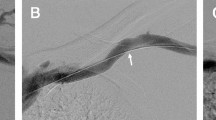Abstract
Purpose
To compare the double mesh nitinol stent (DNS) versus the self-expanding stent-graft (SES) in recurrent/resistant cephalic vein arch stenosis in dialysis fistulae.
Materials and Methods
17 cases with recurrent/resistant stenosis of the cephalic vein arch treated with a DNS were compared retrospectively with 18 cases treated with an SES. Stenting was performed either for significant recoil post-angioplasty with high-pressure balloons or in recurrent stenoses. Patients were followed up with Doppler ultrasound in our vascular access surveillance programme. Primary and assisted primary patency rates at 3, 6 and 12 months were estimated by Kaplan–Meier analysis.
Results
Both stents showed 100% technical success immediately post-stenting, defined as residual stenosis < 30%. 3, 6 and 12 month primary patency of the DNS was 82.4%, 69.7% and 28.1% versus 88.9%, 77.8% and 72.2% for the SES. The DNS had a mean primary patency of 242.4 days compared to 896.3 days for the SES (p = 0.021). 12 month assisted primary patency was 88.2% (DNS) and 100% (SES). The DNS had a mean assisted primary patency of 812 days compared to 1390.3 days for the SES, though this did not reach statistical significance. No stent fractures were identified at 2 years in either group.
Conclusion
Both stents had 100% technical success with no stent fractures. SES showed statistically significant higher primary patency. Assisted primary patency was also higher, though this did not reach statistical significance.





Similar content being viewed by others
References
Clinical Practice Guideline: Vascular access for haemodialysis, UK Renal Association. Available at: https://renal.org/wp-content/uploads/2017/06/vascular-access.pdf
National Kidney Foundation. KDOQI clinical practice guidelines and clinical practice recommendations for 2006 updates: hemodialysis adequacy, peritoneal dialysis adequacy and vascular access. Am J Kidney Dis. 2006;48(suppl 1):S1–S322.
Bountouris I, Kritikou G, Degermetzoglou N, Avgerinos KI. A review of percutaneous transluminal angioplasty in hemodialysis fistula. Int J Vasc Med. 2018. https://doi.org/10.1155/2018/1420136.
Ierardi AM, Angileri SA, Brambillasca PM, et al. In-stent restenosis associated with dual-layer Roadsaver carotid artery stent: a retrospective single-center study. Radiol Medica. 2019. https://doi.org/10.1007/s11547-019-01019-7.
Sivananthan G, et al. cephalic arch stenosis in dialysis patients: review of clinical relevance, anatomy, current theories on etiology and management. J Vasc Access. 2014;15(3):157–62.
Quencer KB, Arici M. Arteriovenous fistulas and their characteristic sites of stenosis. Am J Roentgenol. 2015;205(4):726–34. https://doi.org/10.2214/AJR.15.14650.
Kian K, Unger SW, Mishler R, Schon D, Lenz O, Asif A. Role of surgical intervention for cephalic arch stenosis in the “Fistula First” era. Semin Dial. 2008;21(1):93–6. https://doi.org/10.1111/j.1525-139X.2007.00388.x.
Avfs A, Hospitalar C. From the clinic. BiophotonicsInt. 2002;9(8):64. https://doi.org/10.1016/s1529-9430(01)00098-5.
Vasanthamohan L, et al. The management of cephalic arch stenosis in arteriovenous fistulas for hemodialysis: a systematic review. Cardiovasc Intervent Radiol. 2015;38(5):1179–85.
Shemesh D, Goldin I, Zaghal I, Berlowitz D, Raveh D, Olsha O. Angioplasty with stent graft versus bare stent for recurrent cephalic arch stenosis in autogenousarteriovenous access for hemodialysis: a prospective randomized clinical trial. J Vasc Surg. 2008. https://doi.org/10.1016/j.jvs.2008.07.071.
Miller GA, Preddie DC, Savransky Y, Spergel LM. Use of the Viabahn stent graft for the treatment of recurrent cephalic arch stenosis in hemodialysis accesses. J Vasc Surg. 2018;67(2):522–8. https://doi.org/10.1016/j.jvs.2017.08.018.
Jones RG, et al. Results of stent graft placement to treat cephalic arch stenosis in hemodialysis patients with dysfunctional brachiocephalic arteriovenous fistulas. J VascIntervRadiol. 2017;28(10):1417–21.
Tang TY, Tan CS, Yap CJQ, et al. Helical stent (SUPERATM) and drug-coated balloon (Passeo–18 LuxTM) for recurrent cephalic arch stenosis: Rationale and design of arch V SUPERA–LUX Study. J Vasc Access. 2019. https://doi.org/10.1177/1129729819881589.
Funding
This study was not supported by any funding.
Author information
Authors and Affiliations
Ethics declarations
Conflict of interest
The authors declare that they have no conflict of interest.
Human and Animal Rights
All procedures performed in studies involving human participants were in accordance with the ethical standards of the institutional and/or national research committee and with the 1964 Helsinki declaration and its later amendments or comparable ethical standards. For this type of study, formal consent is not required. This study was approved by the Trust Audit Department. This article does not contain any studies with animals performed by any of the authors.
Informed Consent
For this type of study, informed consent is not required.
Consent for Publication
For this type of study, consent for publication is not required.
Additional information
Publisher's Note
Springer Nature remains neutral with regard to jurisdictional claims in published maps and institutional affiliations.
Rights and permissions
About this article
Cite this article
Mehta, S.A., Shaikh, U. & Chan, T.Y. Double Mesh Nitinol Stent Versus Self-expanding Stent-graft in Recurrent/Resistant Cephalic Vein Arch Stenoses in Dialysis Fistulae: A Comparative Study. Cardiovasc Intervent Radiol 44, 230–236 (2021). https://doi.org/10.1007/s00270-020-02699-9
Received:
Accepted:
Published:
Issue Date:
DOI: https://doi.org/10.1007/s00270-020-02699-9




